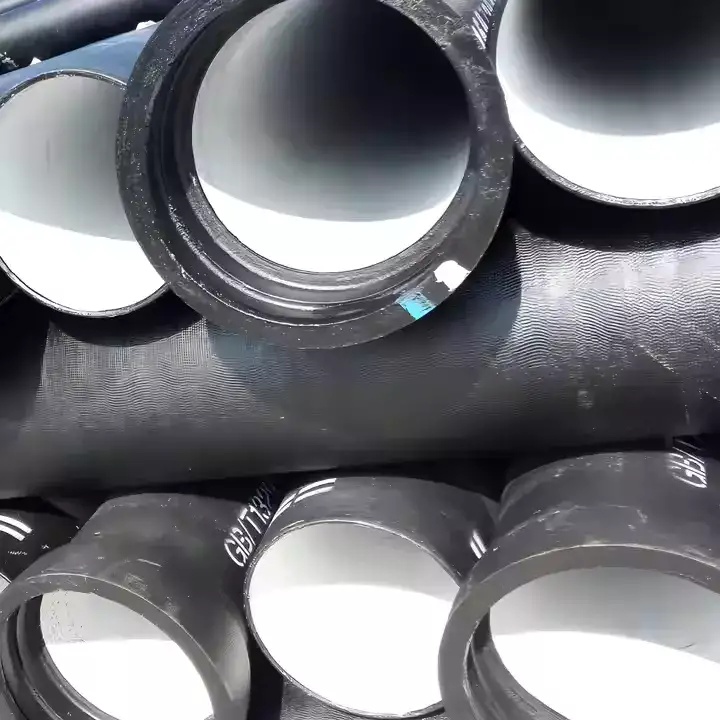Ductile iron pipes are renowned for their strength, durability, and versatility in various applications, particularly in water distribution systems. A distinctive feature of these pipes is the presence of surface dimples, often referred to as “peen marks,” resulting from the centrifugal casting process. However, not all ductile iron pipes exhibit these dimples. The reasons behind the presence or absence of dimples on ductile iron pipes, exploring manufacturing processes, quality control measures, and the implications for pipe performance and applications.

🏭 Manufacturing Process and the Formation of Dimples
Ductile iron pipes are primarily produced through centrifugal casting, where molten iron is poured into rotating molds. The centrifugal force causes the molten iron to move outward, forming the pipe’s inner and outer surfaces. To ensure uniform wall thickness and structural integrity, the molds are often machined with a pattern of dimples or peen marks. These dimples help in the initial build-up of the pipe wall during the casting process.
Factors Influencing the Presence of Dimples
Several factors can influence whether a ductile iron pipe exhibits surface dimples:
-
Mold Design: The presence and pattern of dimples are determined by the design of the casting mold. Some molds may be smooth, resulting in pipes without dimples.
-
Manufacturing Standards: Different manufacturers may adhere to varying standards and practices, leading to differences in the surface characteristics of the pipes.
-
Quality Control Measures: Stringent quality control processes may result in the removal or smoothing of any surface imperfections, including dimples.
🧪 Quality Control and Surface Treatment
Quality control is paramount in the production of ductile iron pipes to ensure they meet industry standards and are free from defects. Surface treatments, such as grinding or polishing, may be employed to remove imperfections, including dimples, to achieve a smooth surface finish. These treatments enhance the pipe’s appearance and may be necessary for specific applications where surface smoothness is critical.
📊 Comparison: Dimpled vs. Non-Dimpled Ductile Iron Pipes
| Feature | Dimpled Ductile Iron Pipe | Non-Dimpled Ductile Iron Pipe |
|---|---|---|
| Manufacturing Process | Centrifugal casting with peened molds | Centrifugal casting with smooth molds |
| Surface Texture | Textured with dimples | Smooth |
| Corrosion Resistance | Enhanced due to surface texture | May require additional coatings |
| Applications | General water distribution | Specialized applications requiring smooth surfaces |
| Cost | Generally lower | May be higher due to additional processing |
🔍 Applications and Implications
The presence or absence of dimples on ductile iron pipes can influence their suitability for various applications:
-
Water Distribution Systems: Both dimpled and non-dimpled pipes can be used effectively, depending on the specific requirements of the system.
-
Specialized Applications: In applications where surface smoothness is critical, such as in certain industrial processes, non-dimpled pipes may be preferred.
-
Corrosion Resistance: The textured surface of dimpled pipes can enhance corrosion resistance, making them suitable for aggressive environments.
🎥 Related Video
For a visual understanding of the ductile iron pipe manufacturing process, including the formation of surface dimples, watch the following video:
❓ Frequently Asked Questions (FAQs)
1. Why do some ductile iron pipes have dimples while others do not?
The presence of dimples on ductile iron pipes is primarily due to the design of the casting molds used during the manufacturing process. Molds with peened patterns impart dimples onto the pipe surface, while smooth molds result in a dimple-free surface. Additionally, manufacturing standards and quality control measures can influence the final surface characteristics of the pipes.
2. Are dimples on ductile iron pipes indicative of poor quality?
No, dimples are a natural result of the centrifugal casting process and do not necessarily indicate poor quality. In fact, they can enhance the pipe’s structural integrity and corrosion resistance. However, excessive or irregular dimples may be a sign of issues in the manufacturing process and should be evaluated.
3. Can the dimples on ductile iron pipes be removed?
Yes, surface treatments such as grinding or polishing can be applied to remove or smooth out the dimples on ductile iron pipes. These treatments are often used to meet specific application requirements where a smooth surface is necessary.
4. Do non-dimpled ductile iron pipes have better corrosion resistance?
Not necessarily. While the textured surface of dimpled pipes can enhance corrosion resistance, non-dimpled pipes can also be designed with protective coatings or linings to achieve similar levels of corrosion resistance. The choice between dimpled and non-dimpled pipes depends on the specific environmental conditions and application requirements.
5. Are non-dimpled ductile iron pipes more expensive?
Non-dimpled ductile iron pipes may incur additional costs due to the extra processing steps required to achieve a smooth surface finish. These costs can vary depending on the extent of surface treatment and the specific requirements of the application.
6. Can both dimpled and non-dimpled ductile iron pipes be used in the same system?
Yes, both types of pipes can be used in the same system, provided they meet the necessary specifications and standards. Consideration should be given to factors such as joint compatibility, pressure ratings, and environmental conditions to ensure the system’s overall performance and integrity.
References:
- Ductile Iron Pipe – Wikipedia
- AWWA C151/A21.51 – Ductile-Iron Pipe, Centrifugally Cast (AWWA)
- ISO 2531:2009 – Ductile Iron Pipes, Fittings, Accessories and Their Joints for Water Applications
- Ductile Iron Pipe Manufacturing Process – DIPRA (Ductile Iron Pipe Research Association)
- ASTM A536 – Standard Specification for Ductile Iron Castings (ASTM International)

